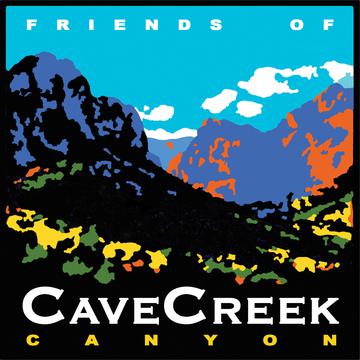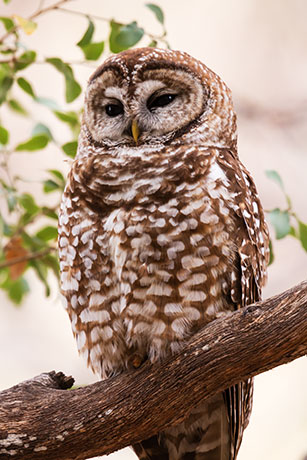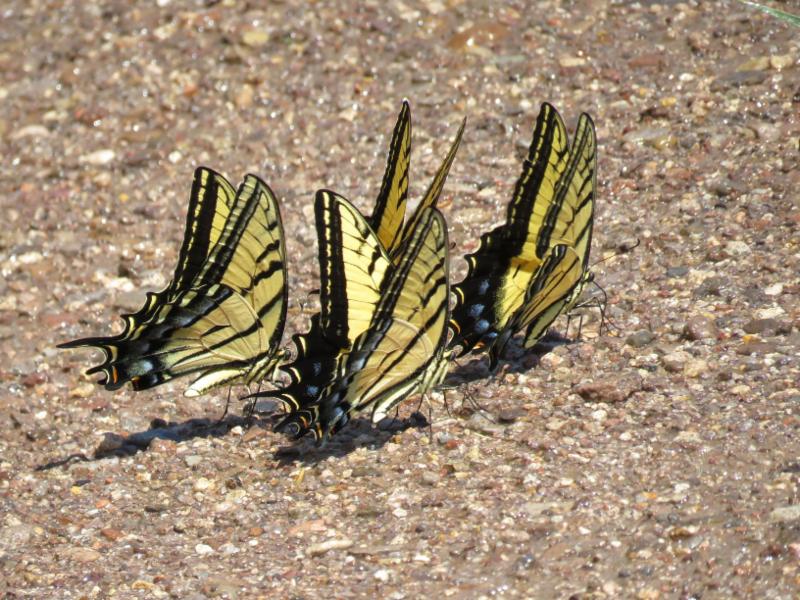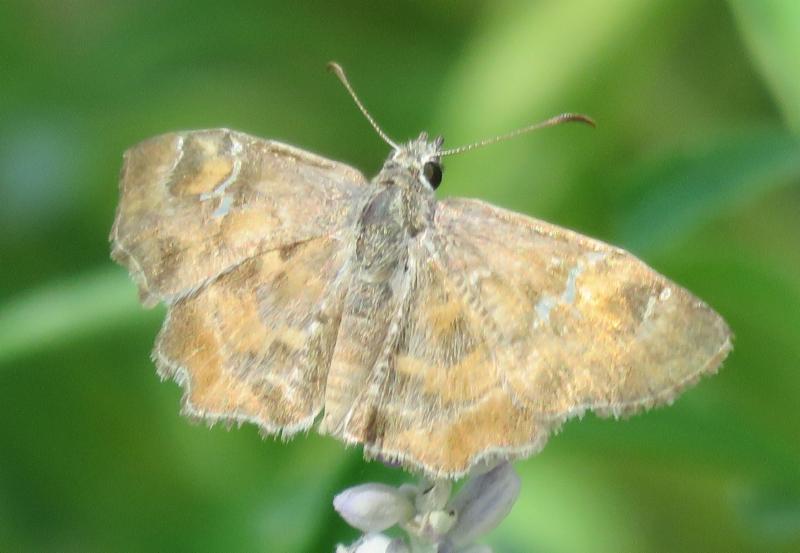|
|

To Friends Of
Cave Creek Canyon
|
|
SPOTTED OWLS
by Helen Snyder
[Photo by Rose Ann Rowlett]
The Cave Creek Canyon area boasts an astounding eleven species of breeding owls, and an additional one that winters here. One that many birders hope to see is our local Mexican Spotted Owl, one of three subspecies of the Spotted Owl. It is the western counterpart of the Barred Owl and ranges from Canada into Mexico. It's considered Endangered in Canada and all the US populations are listed as Threatened.
More northerly US populations in the California and Pacific Northwest became the subject of intense controversy in the 1990s due to the owl's preference for old-growth, high-value timber that led to conflicts with timber harvesting. This produced an explosion of research efforts, and now the Spotted Owl is the best-studied owl in North America. Our population is considered Threatened at the Federal level, but the Sky Island populations on the Coronado National Forest get de facto protection from our inaccessible steep terrain that lacks roads and large stands of harvestable timber. Years of research on the Coronado National Forest in the 1990s produced maps and data showing a widespread and remarkably stable population of this bird.
[Photo by Jackie Lewis]
Surprisingly, the 222,000-acre Horseshoe II fire in 2011 proved less of a disaster for our Chiricahua Spotted Owls than feared. It burned through a number of our Spotted Owl territories but most of the pairs survived as did pockets of habitat, and in fact researchers were surprised to find that the post-fire nesting efforts fledged more young per pair than they did before the fire. This is likely due to more light reaching the ground, increasing plant productivity which in turn enhanced rodent reproduction, temporarily at least.
The Chiricahuas are home to at least eighteen pairs and probably a lot more. The Cave Creek Canyon drainage itself is home to seven pairs, unchanged since the early 1990s.
They are denizens of the mixed conifer and Madrean pine-oak woodlands, preferring cool shady sites with older trees, closed canopy overhead and dense cover. They nest in broken snag tops, old stick nests built by other birds, clumps of mistletoe and cliff-side potholes. Like many owls they often fledge before capable of flight, probably because it's a tradeoff between remaining subject to predation in the powerfully odiferous nest versus the risk of scattering early when capable only of gliding flight to the ground followed by a hike across the forest floor before climbing into a tree to perch. In July these fluffy fledglings reliably appear along several of our roads, approachable and easily seen in the daytime for a few weeks to the delight of birders. They roost with siblings and parents nearby for weeks or months as hunting skills are developed.
  [Adult photo by Robert Shantz] [Adult male photo by Jackie Lewis] [Adult photo by Robert Shantz] [Adult male photo by Jackie Lewis]
How to reliably see one? Technically, their
federal status of Endangered
means
vocalization playback should not be
used. Nests are hard to find and are best not disturbed when located, so the best way to see these comedic characters is with the help of a guide or someone local who has located fledglings that are off and away from the nest but not very mobile yet, and still being fed by the adults in late June or July. At this life stage, they appear to have no fear of people and sleepily gaze back at us between naps as gaggles of birders film and snap away. If you listen quietly a half-hour after sunset near the fledglings, and you may be rewarded first with the unearthly yowling wake-up call of an adult and then with the sight of dark silent wings gliding overhead with a mouse to the youngsters.
Mexican Spotted Owls feed mainly on packrats and smaller rodents; about 5% of the diet is birds. Whiskered Owls are a surprisingly regular avian diet item. Spotteds are non-migratory and established pairs remain near home base year round, and their use of the same day-time roosts tree year after year makes them reliably findable. Two such roost areas along hiking trails in the Huachucas in Miller and Scheelite canyons have been the go-to sites for years, and one such dependable but off-trail site in the Chiricahuas, first discovered by Walter Spofford, sent people crawling up the steep scree slope above Cave Creek Ranch in the 1970s.
We can rejoice in the fact that the Chiricahuas have been designated as one of Audubon's Important Bird Area (IBA), first at the Continental level and then at the Global. The IBA program quantifies and identifies areas of either outstanding avian biodiversity, or ones that have critical concentrations of certain species. IBAs are ranked as important at the Local, State, Continental and Global level. When I noticed in 2007 that by demonstrating that we had 18 pairs of Spotted Owls we could achieve the status of a Globally Important Bird Area I re-surveyed 18 territories in 2008-2009, and we were awarded Global IBA status. Having such a designation will help in future conservation efforts of this area of remarkable owl diversity.
|
The 2019 Monsoon Season
by Mike Leuthold
The old saying for the monsoon is "a wet winter, a dry summer" and that has undoubtedly been the case so far this monsoon season. This didn't come as a big surprise to us meteorologists, as we predicted a late start. The jet stream has been more wavy than average the past few months resulting in delaying the seasonal shift of mid-atmosphere winds from westerly to southerly and southeasterly. This shift in wind direction is responsible for importing moisture from Mexico into Arizona.
How dry has it been? The below plot shows that almost all areas of the state are below normal during the past month with some areas way below normal.
It's not just the southwestern US that has been dry, but almost all of Mexico too, which also impacts our precipitation here in Arizona. Over the past few weeks, the wind pattern over Arizona has shifted to the typical southeasterly flow of the monsoon season but without much increase in precipitation. One crucial process for the moistening of our atmosphere is the recycling of rain that has recently fallen in Mexico by both evaporation from wet ground and transpiration from plants.
Why isn't it raining much in Mexico? I believe it is because of the eastern Pacific hurricane season has also been below normal. By this time, the average number of named storms is six, but there have only been four so far. Only one of those has been anywhere close to the mainland of Mexico. These tropical systems are an essential source of moisture for the monsoon season in Mexico.
Another old saying is "dry July, wet August" so there is some hope the second ½ of the season will improve. The tropical storm formation regions off of southern Mexico could become much more active in August and September which would eventually result in more moisture and precipitation for Arizona. As July was so dry, we wouldn't be able to catch up even with an average amount of precipitation for the rest of the season. I guess this is payback for Arizona's relatively cool and wet winter and spring.
Mike Leuthold is the manager of the Regional Weather Modeling Program at the University of Arizona, Department of Hydrology and Atmospheric Sciences. His family are members and long-term supporters of FoCCC.
[Editor's note: Mike and I agreed that as soon as he wrote this article about the dryness, it would bring on moisture, akin to washing a car to bring on rain. It rained the night I received the article and the next day and the next day the Visitor Information Center got 3.1" of rain in 1.25 hours! Thank you Mike for inducing the rain.]
|
|
Nesting Gray Hawk in Cave Creek Canyon
First Known Nesting Record in the Canyon
Only second record in the Chiricahua Mountains
One of the Camp Chiricahua leaders, Brian Gibbons,
took this picture of the juvenile Gray Hawk.
|
|
Butterflies of Cave Creek Canyon
Article and Photos By Lori Conrad
 Two-Tailed Swallowtails Two-Tailed Swallowtails
On July 25th, the annual Portal Butterfly Count took place here in the beautiful Chiricahuas. This is a count that has been occurring every summer since 2009, sporadic before then. Previous to our moving to Portal, we used to come all the way from southern California to participate in this count. This year, I actually took over as the official compiler for the Portal count. All butterfly data is recorded & submitted to the North American Butterfly Association (NABA) each year, for use in conservation efforts, etc.
 Arizona Powdered Skipper Arizona Powdered Skipper
There are many other butterfly counts that occur every year, all across the US. All of these counts help i
n the conservation of butterflies and butterfly-rich areas, based on the wealth of information that is gathered from the counts over the years. We also participate in several other counts in southeast Arizona every year, including one in the Santa Rita mountains south of Tucson, & also our all time favorite count, in
Patagonia,
AZ. That count has been ranked one of, if not THE, top butterfly counts in the nation over the years, mainly due to the high number of species counted on each summer's count day. If Portal gets a total of 40 different species on count day, Patagonia rarely has under 100.
Diamond Flowers
[
Pygmy Bluets]
This year, we had very few flowering plants in the lowe
r Chiricahuas, faring a bit better as we gained elevation. Many of the plants lower down bloomed early this year due to all of the rain & snow melt, then haven't bloomed a second time yet because our summer monsoonal rain is a bit late.
Despite these factors, we still managed to tally approximately 62 species this time!

Dull Firetip
We had a decent count this year, mostly thanks to some wonderful gardens in town. Barbara Miller has an amazing garden & she has allowed us to count butterflies there for a few years now. Thanks, Barbara! Our own garden supplied us with a few species not seen elsewhere, & the garden at the Visitor Information Center provided a few more goodies. Thanks to Cathie for turning on the sprinklers prior to our arrival.........some butterflies just can't resist moist soil! Lastly, thanks to the Southwestern Research Station for maintaining their gardens with several butterfly-friendly plants. A few more species were added there.
Golden-Banded Skipper & 2 Cassus-Roadside Skippers
So, if you thi
nk you would like to p
ar
ticipate next year, please let me know. All levels are welcome, as you can be with a knowledgeable leader throughout the day, if you wish. It's a great way to learn your butterflies.....that's how we did it!
Also seen on the Butterfly Count was this
Canyon Rubyspot Dragonfly
|
|
|
Wonderful Donation To FoCCC!
Some generous donors were going to give us a donation. Their CPA told them to give appreciated stock instead. They were told to give stock that they had a profit in - not cash - an
d they wouldn't have to pay income taxes on the donated stock. It certainly made no difference to us and it certainly helped the donors.
They gave us some of their appreciated stock, which we sold, generating almost $24,000.
These proceeds will be reserved for the biggest project FoCCC has ever done: the
South Fork Educational & Recreational Facilities Project!
You will learn more about this large and important project in the future. Perhaps like our generous benefactor above, you would like to make a donation. Also, maybe you have some nicely appreciated stock. A donation of that could reduce your taxes [check with your tax advisor], and support this incredible project in an area you love.
|
|
Relocated South Fork Trail
Volunteers recently worked to relocate the trail from the berm at the end of the South Fork Road to the old trail head and former picnic area.
The volunteer event was coordinated by Jonathan Patt of Wild Arizona (formerly the Arizona Wilderness Coalition) as part of its grant with the Coronado National Forest for the YCC program, FoCCC members and other volunteers.
They were able build a NEW South Fork trail route over a 2 day period. It's approximately 1/3 of a mile long and provides a much more pleasant and scenic route that keeps hikers away from the cobble-covered (and often water-covered) old roadbed.
|
Gila Monsters
By Mike Jacobi
The Gila monster ( Heloderma suspectum) is one of Portal's most elusive residents. This venomous lizard spends much of its time in shelters below ground or in rock crevices and is seldom seen. They have short activity periods for breeding and feeding that are centered around the monsoon season, and can subsist on only a handful of meals during the year. They are most often discovered at dawn or dusk, and after rains. This juvenile [below left] was spotted near downtown Portal after dark on July 28, while the adult in the other two photos was observed the 20th of July at dusk in the foothills just outside of Portal.
|
|
Friends Of Cave Creek Canyon
New Membership Category
Become a Lifetime Member of FoCCC!
For $1500 you will be a Lifetime Member:
- Part of you membership supports the new South Fork Educational and Recreational Project
- Never have to remember to renew your membership
- Become a lifetime supporter and Sustainer's Circle member
You can be our Second Lifetime Member!
|
|
FOCCC 2019 Officers and Board
Reed Peters President
Other Board Members
Sheri Ashley Vice President
Bob Ashley
Wynne Brown
Mike Williams Vice President
Alan Craig
Rene Donaldson
Rick Beno
Treasurer
Stevie Wayman Secretary
Cecil Williams
FOCCC Board of Directors meets on the first Wednesday morning each month at the Chiricahua Desert Museum on Highway 80. If you have interest in attending or putting something on the agenda, please contact President Reed Peters at 520-558-2334. All members are welcome to attend.
|
| 
Friends Of Cave Creek Canyon
PO Box 16126
Portal, Arizona 85632 Visit Our Website |
Thanks to our "Sustainer's Circle" members
for their generous support:
Tom Arny, Bob and Bettina Arrigoni, Susan Dalby & Eskild Peterson, Nancy and Thomas Denney, Mary George, Bill and Sally Hague, Paul Hirt and Linda Jakse, Don Hollister, Pi Irwin and Zsombor Zoltan, Ken Jenkins, Leuthold Family Foundation, Barbara Lounsbery, Patrick McNamara, John and Karin McQuillan, Barbara and Pete Miller, Patricia Parran, Tom Roseman and Paula Baldwin, Delia Scholes, Donald and Martha Squire and Bob and Sherry Zoellick.
|
|
Please support our Business Members who have given generously to Friends Of Cave Creek Canyon. Without their assistance, we would be hard pressed to accomplish our goals. Click on their names to check out their websites.
Business Memberships start at just $50.00!
|
|
|
|
|